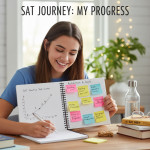How to Prepare for the SAT Without Losing Sleep
Introduction: Calm over Cram
Take a deep breath. If the SAT feels like a looming mountain, you’re in the right place. This guide is for the student who wants results without sacrificing sleep, mental health, or the little joys of everyday life. The Digital SAT is different from the paper test in layout and tools, but one truth remains: steady, smart preparation beats last-minute cramming every time.
Here you’ll find a realistic, humane plan—backed by study-smart techniques, practical schedules, and real-world examples—that helps you maximize score gains while keeping your energy levels and sleep intact. I’ll also point out when personalized help makes sense (for instance, Sparkl’s personalized tutoring can be a fit when you need 1-on-1 guidance or tailored study plans). No hype, no all-nighters—just a reliable path forward.
Why Sleep Matters for SAT Performance
This isn’t optional: sleep is part of studying. Learning, memory consolidation, attention, and reasoning all depend on regular, quality sleep. Skipping sleep for one night before a practice test will often make your score dip, even if you spent hours memorizing formulas late into the night.
- Sleep consolidates learning: your brain files away what you practiced during the day.
- Rested attention = fewer careless errors on reading passages and math problems.
- Consistent sleep creates predictability for test-day energy.
So the goal isn’t to study 24/7. The goal is to study effectively and sleep well, because both together reliably improve performance.
Understand the Digital SAT So You Can Study Smarter
Before you design a schedule, know the terrain. The Digital SAT is shorter, adaptive in sections, and offers built-in tools like a graphing calculator for most math questions. Shorter passages and more time per question change how you pace yourself and where you should focus practice.
- Digital format: practice with the Bluebook app and adaptive practice tests to get comfortable with screen-based timing and tools.
- Built-in calculator: rely on practicing with the same calculator you’ll have during testing.
- Adaptive sections: practice strategic question selection—early correct answers affect later difficulty.
Practice the format as much as you practice content. Taking official digital practice tests is one of the highest-impact study decisions you can make.
Designing a Sleep-Friendly SAT Study Plan
The plan below assumes you have 8–12 weeks before your test. If you have more or less time, scale the blocks proportionally. The heart of the plan: short, focused daily sessions, weekly practice tests, deliberate review, and routine sleep hygiene.
Weekly Structure (Example for a 10-week timeline)
- Daily: 45–75 minutes of focused study (most days). Keep this time consistent—same window each day helps habit formation.
- 3 days/week: content practice alternating Reading/Writing and Math.
- 1 day/week: targeted skills work (grammar rules, algebra strategies, data interpretation).
- 1 full-length practice test every 7–10 days, ideally on the same weekday and time as your planned test day.
- 1 rest day: light review only—no heavy practice or timed sections.
Sample Daily Template (60 minutes)
- 10 minutes — Warm-up (e.g., 5 reading comprehension questions or a grammar quick set)
- 35 minutes — Focused practice (timed section or problem set)
- 10 minutes — Review mistakes (write down one rule or technique to remember)
- 5 minutes — Plan action for the next day
Consistency beats marathon sessions. A compact, daily plan preserves sleep while delivering cumulative learning.
Practical Study Techniques That Respect Your Sleep
These techniques are simple but powerful when used consistently.
1) Spaced Practice
Study a topic several times over days or weeks instead of once for hours. Spacing promotes long-term retention and reduces the need for panic review sessions.
2) Active Retrieval
Close the book and try to reproduce an explanation or solve a problem without looking. Active recall is far more efficient than passive rereading.
3) Error Logs
After each practice session, write down the mistake, why it happened, and how to avoid it. Reviewing error logs takes less time and yields better results than repeating random problem sets.
4) Simulate Digital Conditions
Practice on a device and with the same tools you’ll use on test day. The Bluebook practice environment and Official SAT Practice on Khan Academy can mimic the real experience.
How to Schedule Practice Tests Without Ruining Your Sleep
Full-length practice tests are essential, but they’re also draining. Use these rules so a test helps more than it harms.
- Schedule tests for morning slots if your actual test will be in the morning. Your energy rhythm matters.
- After a practice test, do a light review that same day; save deep analysis for the next day.
- If a practice test leaves you wired, use relaxation techniques—short walks, breathing, or a warm shower—before bed.
- Never follow a test with all-night cramming. The brain needs sleep to process the test experience into useful learning.
Smart Time Management on Test Day
Make the morning predictable: a stable wake time, a balanced breakfast, and a brief warm-up session. The goal is to be alert, calm, and confident.
| Time Before Test | Activity | Why It Helps |
|---|---|---|
| Night Before | Prep materials, device charged, lay out clothes | Reduces morning decision-making and stress |
| 7–9 hours before | Sleep | Memory consolidation and alertness |
| 2 hours before | Balanced breakfast, hydrate | Steady energy and concentration |
| 30–60 minutes before | Short warm-up: 5–10 practice questions or light reading | Activates reasoning circuits without draining energy |
Follow a repeatable routine during practice tests so your body and mind become used to the rhythm. That predictability reduces anxiety and helps you conserve energy for the sections that matter.
Nutrition, Movement, and Stress Management
Your brain is part of a body. Simple lifestyle moves create huge differences in how you perform.
- Nutrition: Aim for protein and complex carbs at breakfast (e.g., eggs and toast, yogurt and oats). Avoid heavy sugars that produce crashes.
- Movement: Short walks or 10 minutes of light exercise in the morning can boost attention.
- Mindfulness: Learn two quick breathing exercises to calm nerves during the test—box breathing and 4-4-4 breathing are easy and effective.
When you prioritize these small habits, you protect your sleep and sharpen the mind that will take the exam.
When to Get Personalized Help (and How It Keeps You Rested)
Personalized tutoring isn’t for everyone, but for many students it dramatically increases efficiency: fewer hours studying, bigger gains. If you find yourself stuck on the same set of mistakes, overwhelmed by planning, or short on time, targeted 1-on-1 guidance can help.
For students who choose tutoring, look for programs that offer:
- Tailored study plans that respect your schedule and sleep needs.
- Expert tutors who explain the ‘why’ behind strategies, not just the steps.
- Actionable feedback and regular progress checks.
For example, Sparkl’s personalized tutoring model combines 1-on-1 guidance, tailored study plans, expert tutors, and AI-driven insights that help you focus on the few things that will move your score—so you don’t have to stretch study time into sleepless nights. When tutoring reduces confusion and accelerates learning, you can study less and sleep more while improving your score.
Examples: How Smart Strategies Beat Long Hours
Let’s look at two fictional students and how they prepare differently.
Case 1: Maya – The Marathon Crammer
Maya studies 6–8 hours the night before a practice test, sleeping 3–4 hours and feeling exhausted the next day. She repeats mistakes and gets frustrated, which leads to longer, less effective study periods. Her pattern spirals: more cramming, more exhaustion, smaller gains.
Case 2: Jordan – The Strategist
Jordan studies 60 minutes daily with spaced practice, uses error logs, takes one practice test every 10 days, and sleeps 8 hours regularly. When Jordan gets stuck on a type of algebra problem, he schedules two 1-hour sessions with a tutor who gives a focused technique and a brief practice set. Jordan’s score improves steadily with minimal stress and consistent sleep.
The takeaway: focused, targeted practice beats raw hours. If you’re short on time, targeted help (even a few high-quality tutoring sessions) can be the multiplier that saves hours and preserves sleep.
How to Review Practice Tests Efficiently
After each full-length test, prioritize the following review steps so you learn well without spending endless hours:
- First pass (same day): Quickly categorize mistakes—careless, concept, pacing.
- Second pass (next day): Deep dive into concept errors; create 3–5 targeted practice problems.
- Weekly summary: Look for patterns across tests and adjust your study plan.
Use your error log as a living document. Over time, it becomes a condensed cheat-sheet of your most persistent traps and the strategies that correct them. Reviewing the error log for 10–15 minutes before sleep (earlier in the evening, not right at bedtime) can be a gentle, low-stress way to keep information fresh without interfering with sleep.
Practical Tools: What to Practice and Where
Official practice materials should be your foundation. They mirror the test format and question style better than anything else. Complement those with targeted problem sets in weak areas, and use timed drills to build pacing confidence.
- Official digital practice tests — essential.
- Bluebook app — practice the test platform and tools.
- Khan Academy official SAT practice — personalized practice plans that pair well with your practice test results.
- One-on-one tutoring sessions for persistent problem types, pacing, or test anxiety.
When you pair official materials with targeted help, you reduce wasted study time and protect your sleep.
Night-Before and Morning-Of: A Calm Routine
Don’t make the night before the test a study marathon. Instead:
- Evening — light review of error log, pack your bag, charge devices, and sleep early.
- Morning — wake up with time to eat a steady breakfast, hydrate, and do a 10-minute warm-up of light practice questions or reading.
Keep caffeine moderate. Small amounts can help focus, but too much can increase anxiety and disrupt sleep that night—especially if you’re taking an afternoon practice test as part of prep.
Common Concerns Students Have (and Calm Solutions)
“I don’t have time—I’m overwhelmed.”
Short, focused daily sessions are better than rare marathon sessions. If you’re truly short on time, prioritize practice tests and error-log review. Consider a tutor who gives a 4–6 week crash plan with daily priorities—this often beats random self-study.
“I forget everything I study.”
Spaced practice and active retrieval are your friends. Use flashcards for key grammar rules and formulas, but test yourself instead of rereading notes.
“I panic on test day.”
Practice under simulated conditions. Add short relaxation routines to your practice tests so your body learns to calm down under pressure. A few guided sessions with a coach or tutor can also teach cognitive techniques to manage anxiety.
Final Checklist: Prepare Without Losing Sleep
- Build a daily, modest study habit: 45–75 minutes most days.
- Schedule one full practice test every 7–10 days and review mistakes efficiently.
- Practice in the digital environment (Bluebook) and use official practice resources.
- Maintain consistent sleep: aim for 7–9 hours every night.
- Use targeted tutoring if you’re plateauing—look for tailored plans and actionable feedback.
- Create a calm, repeatable test-day routine and practice it during full-length tests.
Preparation doesn’t need to mean sacrificing your sleep or sanity. Thoughtful, consistent effort—backed by strategic review and realistic routines—lets you improve your SAT score while living a balanced life. If a few well-chosen tutoring sessions (for example, Sparkl’s personalized tutoring with 1-on-1 guidance and AI-driven insights) could accelerate your progress, they’re worth considering. The point is to work smarter, not endlessly harder.
Parting Thought: Keep Perspective
The SAT is important, but it’s one measure among many. By protecting your sleep and building an intelligent plan, you’ll do your best work and be better prepared for college and beyond. If you’re ever unsure where to start or how to break through a plateau, targeted, compassionate support—structured study plans, expert tutors, and data-driven feedback—can make prep both more effective and less stressful.
Stay curious, rest well, and remember: steady progress—night after night—adds up. You don’t have to sacrifice sleep to succeed. You only need a plan that respects both your goals and your well-being.
Ready to Start?
Pick one small action today: download a digital practice test, write your error log template, or schedule a 60-minute study window for tomorrow morning. Small, consistent steps are the secret to big gains—and a much better night’s sleep.
Good luck. You’ve got this.
















No Comments
Leave a comment Cancel